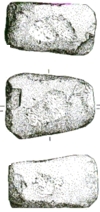


This mine is located on the eastern slopes of Plynlimon, close to the source of the
River Severn, where it’s workings are amongst the most isolated in mid-
Stone tools and an antler pick were found when the open works were cleared out in 1859, and as a result this was one of those sites Oliver Davies looked at when he came looking for ancient mines in Wales in 1937.
The river here now flows through the ancient open cut, and it is tempting to think
that the copper-
In 1988 the EMRG carried out several small excavations of an ancient spoil mound some distance above the east edge of the river chasm, and as a result of this, dates of between 1900 and 1520 years cal BC were obtained from thick accumulations of charcoal.
The group returned in 2014 to re-
and more thoroughly test pit the length of the shallow and presumably ancient spoil mounds over a distance of c. 100 metres.
Twelve pits were dug, the northernmost one confirming the continuation of Early
Bronze Age mining (1900 -
A minimum of 1000-
This website was made possible by a grant from the Cambrian Archaeology Association



Plan of Nantyreira mine (S. Timberlake, 1988.)
Drawing of hammer stone / anvil B. Craddock.)

(S.Timberlake+ B. Craddock after baseline survey by CPAT)
